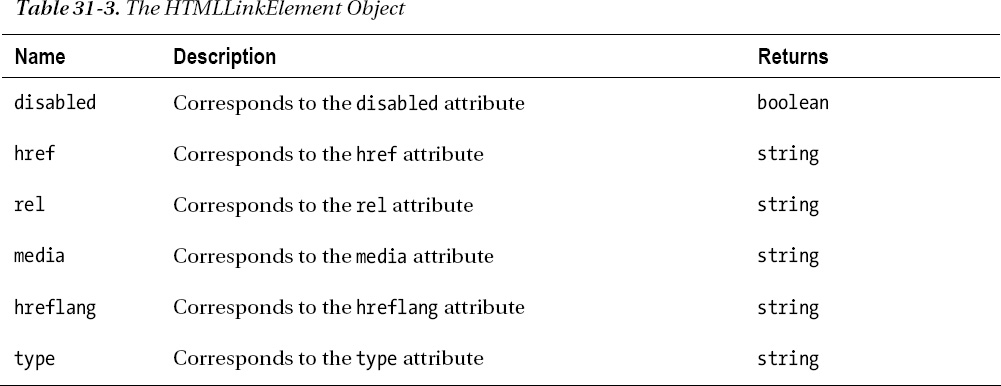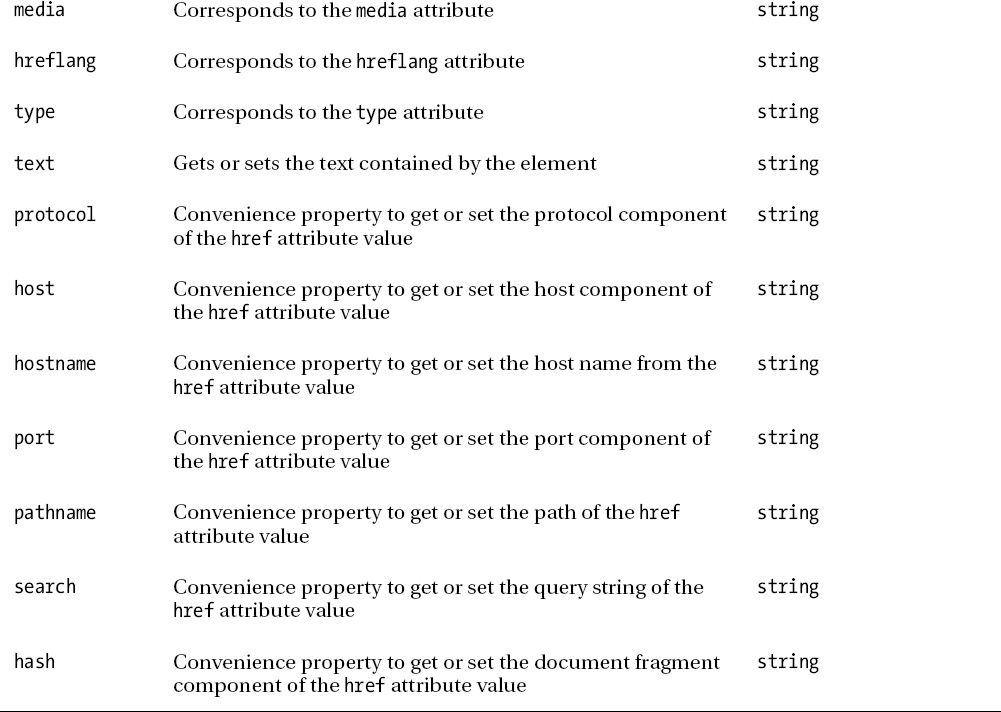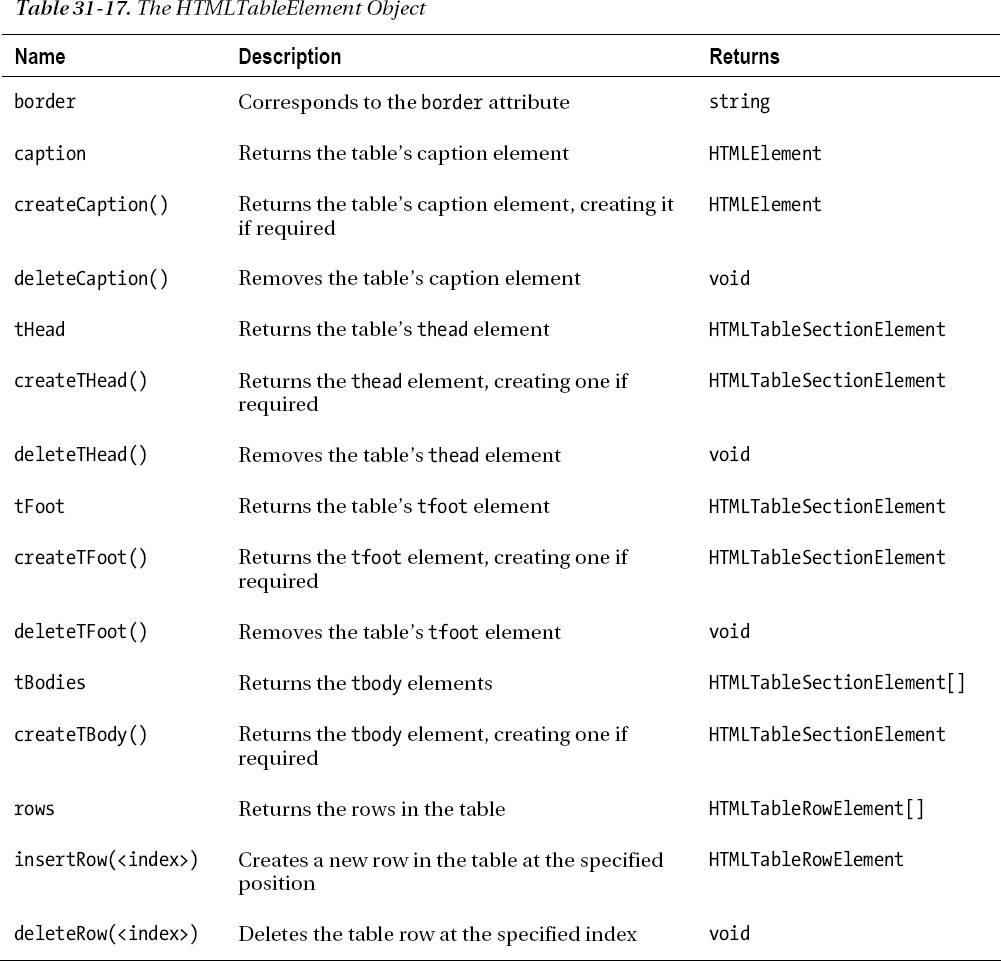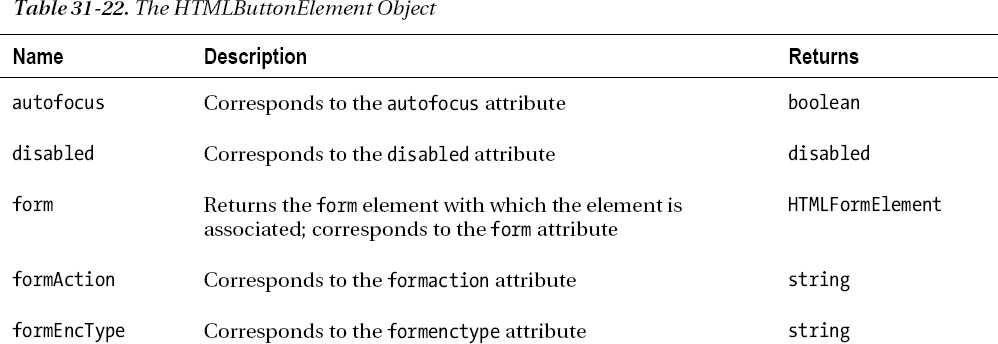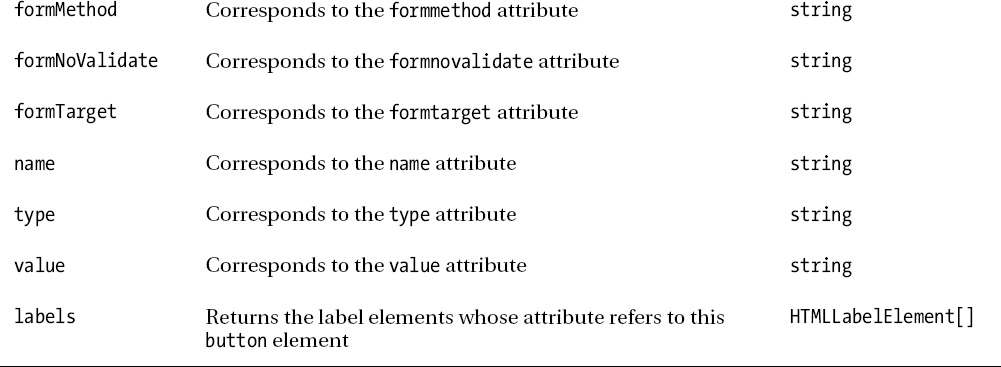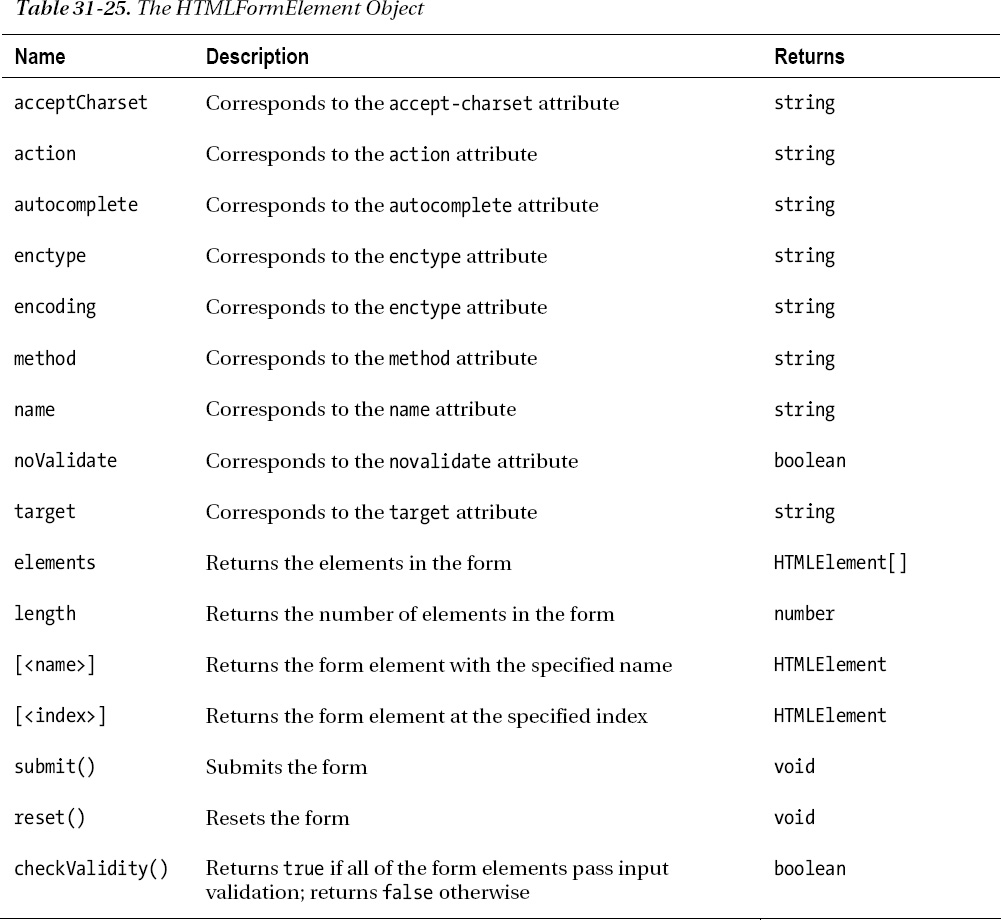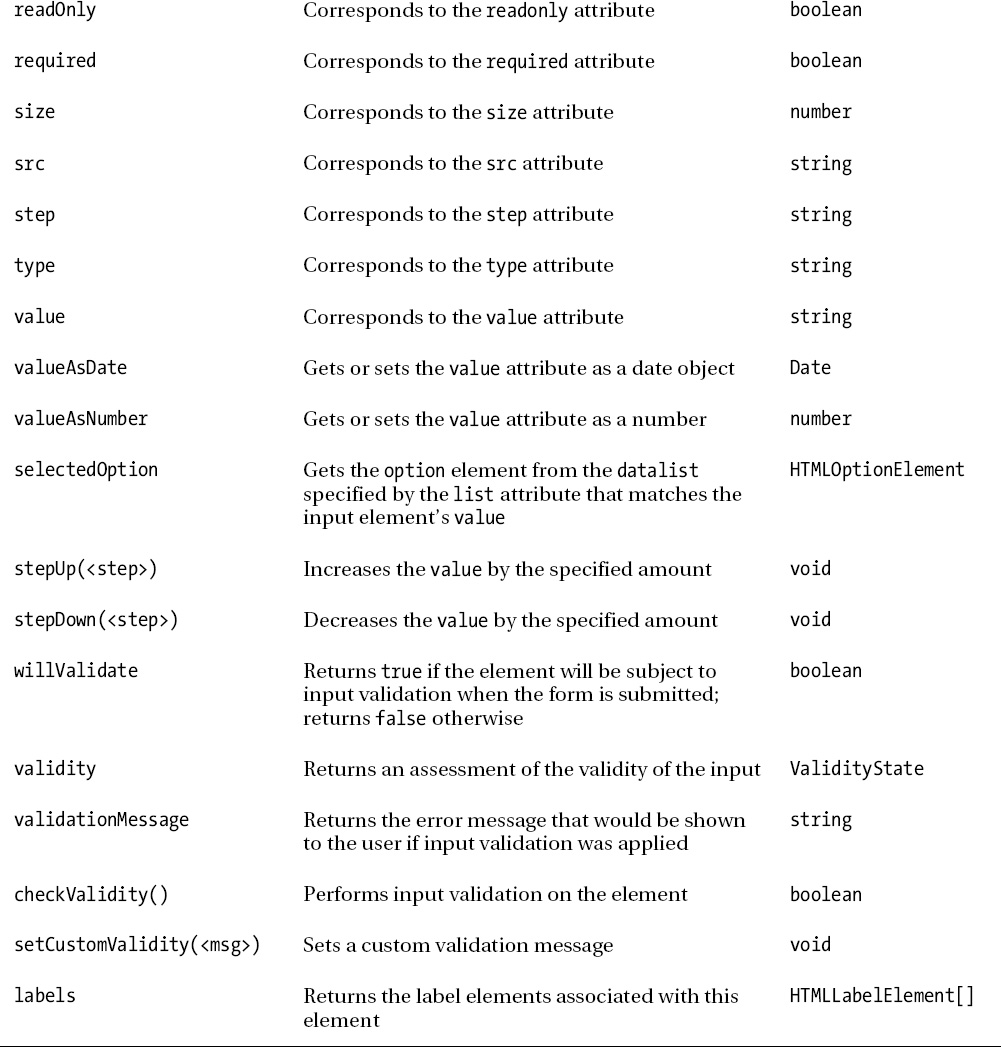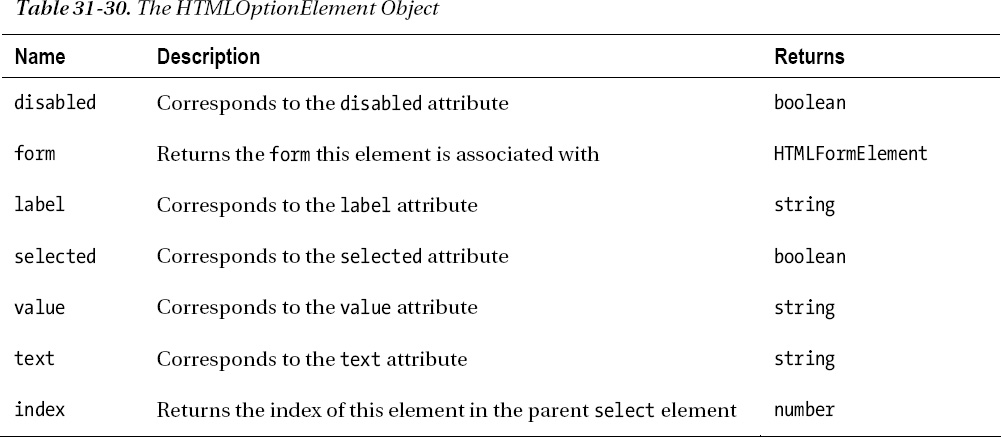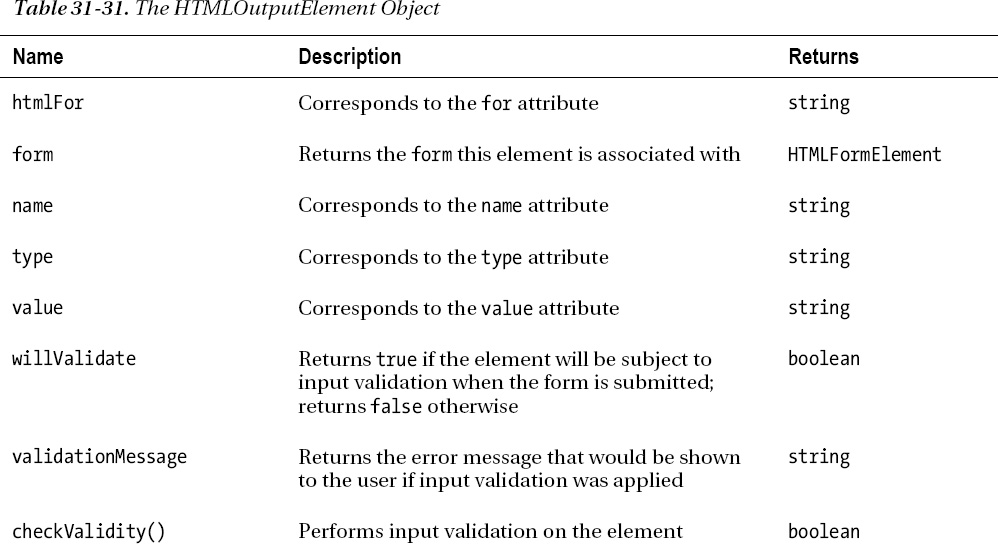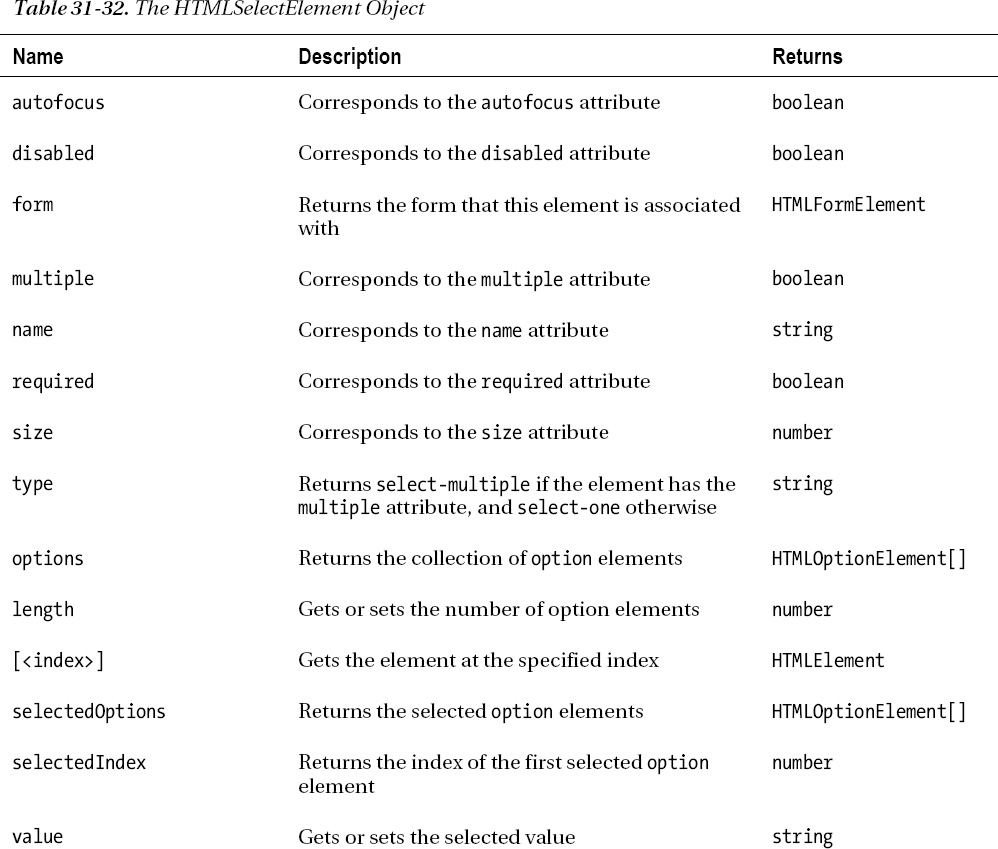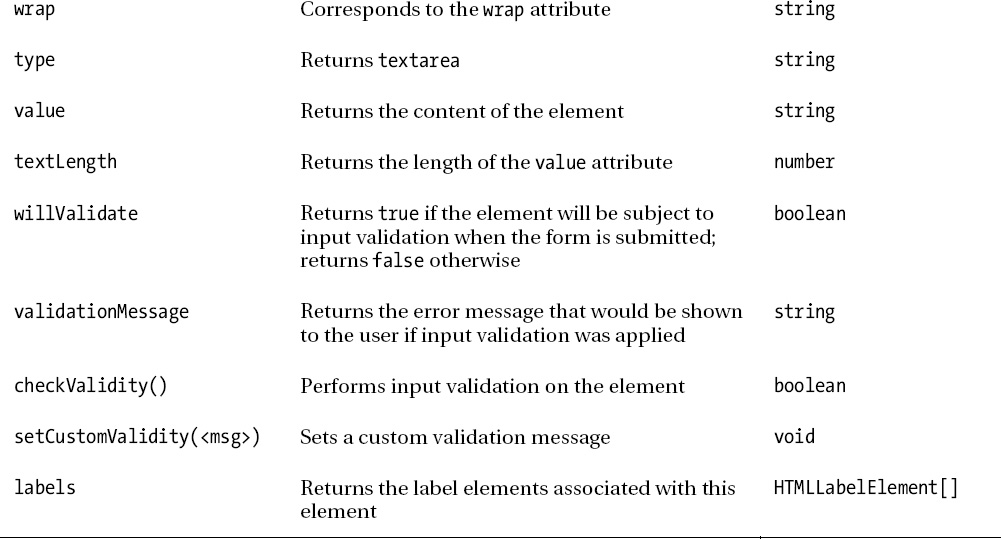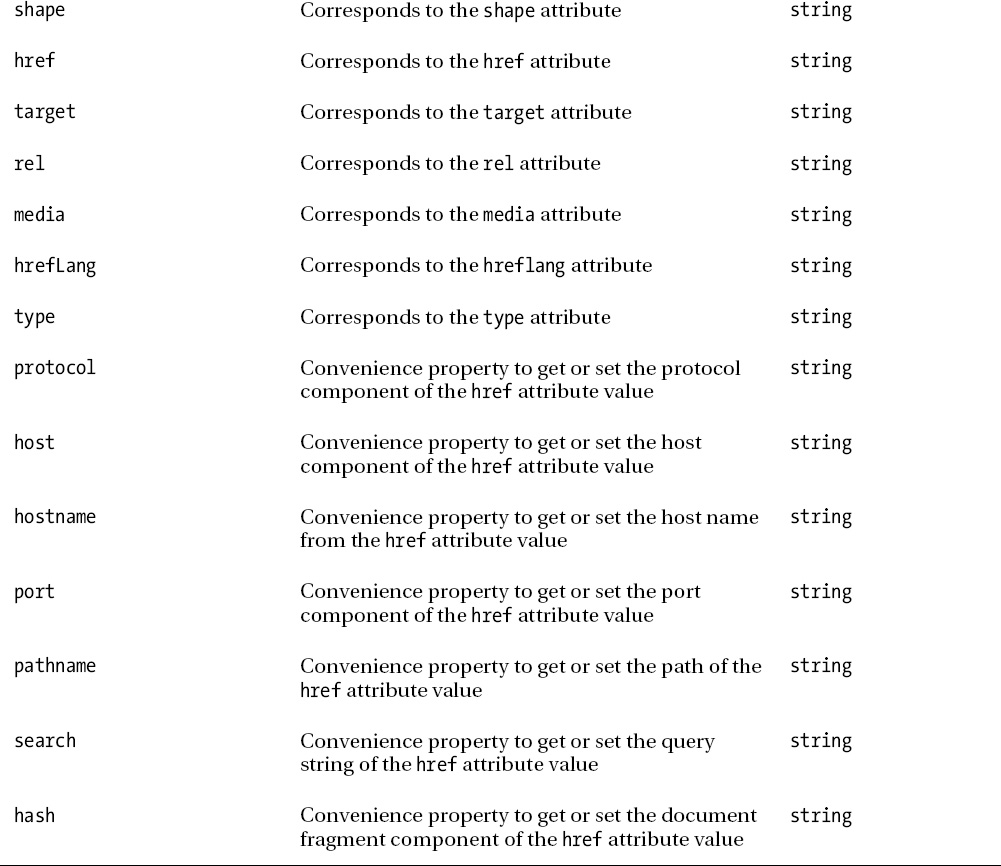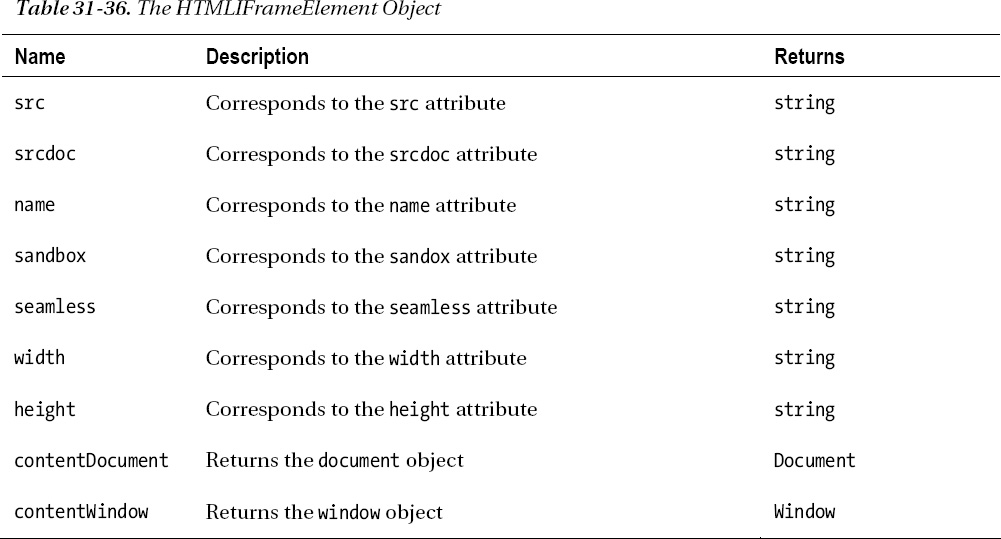C H A P T E R 31
Using the Element-Specific Objects
The Document Object Model (DOM) defines a set of objects that represent the different types of HTML elements in a document. These objects can be treated as HTMLElement objects and, for the most part, that’s what you typically do in your scripts. But if you want to access some attribute or feature that is unique to an element, you can usually do so using one of these objects.
These objects are not much use. They generally define properties that correspond to attributes supported by an element, the value of which you can access through the features of the HTMLElement. There are a couple of exceptions—the form elements have some helpful methods for use with input validation, and the table elements have some methods that can be used to build up the content of tables.
The Document and Metadata Objects
This section describes the objects that represent the data and metadata elements. You can learn more about these elements in Chapter 7.
The base Element
The base element is represented by the HTMLBaseElement object. This object doesn’t define any additional events, but there are two properties, which are shown in Table 31-1.
The body Element
The body element is represented by the HTMLBodyElement object. This object doesn’t define any additional properties, but the set of events is shown in Table 31-2.
![]() Tip Some browsers support these events through the
Tip Some browsers support these events through the window object, which I describe in Chapter 27.
The link Element
The link element is represented by the HTMLLinkElement object, which defines the properties shown in Table 31-3.
The meta Element
The meta element is represented by the HTMLMetaElement object, which defines the properties shown in Table 31-4.
The script Element
The script element is represented in the DOM by the HTMLScriptElement object, which defines the additional properties described in Table 31-5.
The style Element
The style element is represented in the DOM by the HTMLStyleElement object, which defines the additional properties shown in Table 31-6.
The title Element
The title element is represented by the HTMLTitleElement object in the DOM. This object defines the property shown in Table 31-7.
Other Document and Metadata Elements
The head and html elements are represented by the HTMLHeadElement and HTMLHtmlElement objects, respectively. These objects do not define any additional methods, properties, or events beyond those of HTMLElement. The noscript element doesn’t have a special DOM object and is represented solely by HTMLElement.
The Text Elements
This section describes the objects that represent the text elements. You can learn more about these elements in Chapter 8.
The a Element
The a element is represented by the HTMLAnchorElement object, which defines the properties shown in Table 31-8. In addition to defining properties that correspond to the element attributes, this object defines a set of convenience properties that allows you to easily get or set components of the URL specified by the href attribute.
The del and ins Elements
The del and ins elements are both represented by the HTMLModElement. You can tell them apart using the tagName property defined by HTMLElement. See Chapter 26 for details. The additional properties defined by HTMLModElement are described in Table 31-9.
The q Element
The q element is represented by the HTMLQuoteElement object. The property that this object defines is described in Table 31-10.
The time Element
The time element is represented by the HTMLTimeElement object. The additional properties defined by this object are shown in Table 31-11.
Other Text Elements
The br and span elements are represented by the HTMLBRElement and HTMLSpanElementobjects, respectively. These objects do not define any additional methods, properties, or events beyond those of HTMLElement. The following elements are represented solely by HTMLElement: abbr, b, cite, code, dfn, em, i, u, kbd, mark, rt, rp, ruby, s, samp, small, strong, sub, sup, var, and wbr.
The Grouping Elements
This section describes the objects that represent the grouping elements. You can learn more about these elements in Chapter 9.
The blockquote Element
The blockquote element is represented by the HTMLQuoteElement object. This is the same object that the q element uses, which I described in Table 31-10.
The li Element
The li element is represented by the HTMLLIElement object, which defines the property shown in Table 31-12.
The ol Element
The ol element is represented by the HTMLOListElement object, which defines the properties shown in Table 31-13.
Other Grouping Elements
Table 31-14 shows the set of grouping elements that are represented by element-specific objects that do not define any additional functionality beyond that of HTMLElement.
The following elements do not have corresponding elements in the DOM and are represented by HTMLElement: dd, dt, figcaption, and figure.
The Section Elements
This section describes the objects that represent the section elements. You can learn more about these elements in Chapter 10.
The details Element
The details element is represented by the HTMLDetailsElement object. The property that this object defines is described in Table 31-15.
Other Section Elements
The h1-h6 elements are represented by the HTMLHeadingElement object, but this object doesn’t define any additional properties. The following section elements are not represented by specific objects: address, article, aside, footer, header, hgroup, nav, section, and summary.
The Table Elements
This section describes the objects that represent the table elements. You can learn more about these elements in Chapter 11.
The col and colgroup Elements
The col and colgroup elements are both represented by the HTMLTableColElement object, which defines the property shown in Table 31-16.
The table Element
The table element is represented by the HTMLTableElement object. This is one of the most useful of the element-specific objects. The properties and methods defined by this object are described in Table 31-17.
The thead, tbody, and tfoot Elements
The thead, tbody, and tfoot elements are all represented by the HTMLTableSectionElement object. The property and methods defined by this object are shown in Table 31-18.
The th Element
The th element is represented by the HTMLTableHeaderCellElement object. The property defined by this object is described in Table 31-19.
The tr Element
The tr element is represented by the HTMLTableRowElement object, which defines the properties and methods shown in Table 31-20.
Other Table Elements
Table 31-21 shows the set of table elements that are represented by element-specific objects that do not define any additional functionality beyond that of HTMLElement.
The Form Elements
This section describes the objects that represent the form elements. You can learn more about these elements in Chapters 12–14.
The button Element
The button element is represented by the HTMLButtonElement object, which defines the properties and methods shown in Table 31-22.
The datalist Element
The datalist element is represented by the HTMLDataListElement object, which defines the property shown in Table 31-23.
The fieldset Element
The fieldset element is represented by the HTMLFieldSetElement object, which defines the properties shown in Table 31-24.
The form Element
The form element is represented by the HTMLFormElement object, which defines the properties and methods shown in Table 31-25.
The input Element
The input element is represented by the HTMLInputElement object, which supports the properties and methods shown in Table 31-26.
The label Element
The label element is represented by the HTMLLabelElement object, which defines the properties shown in Table 31-27.
The legend Element
The legend element is represented by the HTMLLegendElement object, which defines the property shown in Table 31-28.
The optgroup Element
The optgroup element is represented by the HTMLOptGroupElement object, which defines the properties shown in Table 31-29.
The option Element
The option element is represented by the HTMLOptionElement object, which defines the properties shown in Table 31-30.
The output Element
The output element is represented by the HTMLOutputElement object, which defines the properties shown in Table 31-31.
The select Element
The select element is represented by the HTMLSelectElement object, which implements the properties and methods shown in Table 31-32.
The textarea Element
The textarea element is represented by the HTMLTextAreaElement object, which defines the methods and properties described in Table 31-33.
The Content Elements
This section describes the objects that represent the elements used to embed content in a document. You can learn more about these elements in Chapter 15.
![]() Note The other content elements, such as
Note The other content elements, such as canvas and video, are described later in Chapter 34.
The area Element
The area element is represented by the HTMLAreaElement, which implements the properties shown in Table 31-34.
The embed Element
The embed element is represented by the HTMLEmbedElement object, which implements the properties shown in Table 31-35.
The iframe Element
The iframe element is represented by the HTMLIFrameElement object, which implements the properties described in Table 31-36.
The img Elements
The img element is represented by the HTMLImageElement object, which implements the properties described in Table 31-37.
The map Element
The map element is represented by the HTMLMapElement object, which implements the properties shown in Table 31-38.
The meter Element
The meter element is represented by the HTMLMeterElement object, which implements the properties shown in Table 31-39.
The object Element
The object element is represented by the HTMLObjectElement object, which implements the properties shown in Table 31-40.
The param Element
The param element is represented by the HTMLParamElement object, which implements the properties shown in Table 31-41.
The progress Element
The progress element is represented by the HTMLProgressElement object, which implements the properties shown in Table 31-42.
Summary
In this chapter, I listed the set of objects that are used to represent different types of elements in the DOM. For the most part, these are not especially useful—with two exceptions. The first exception is the form elements, which provide some useful control over validation and form submission. The second exception is the table elements, which provide methods for managing the content of tables. These exceptions aside, the objects described in this chapter are largely a collection of properties that represent specific attributes—the values of which can be accessed through the ubiquitous HTMLElement object.



